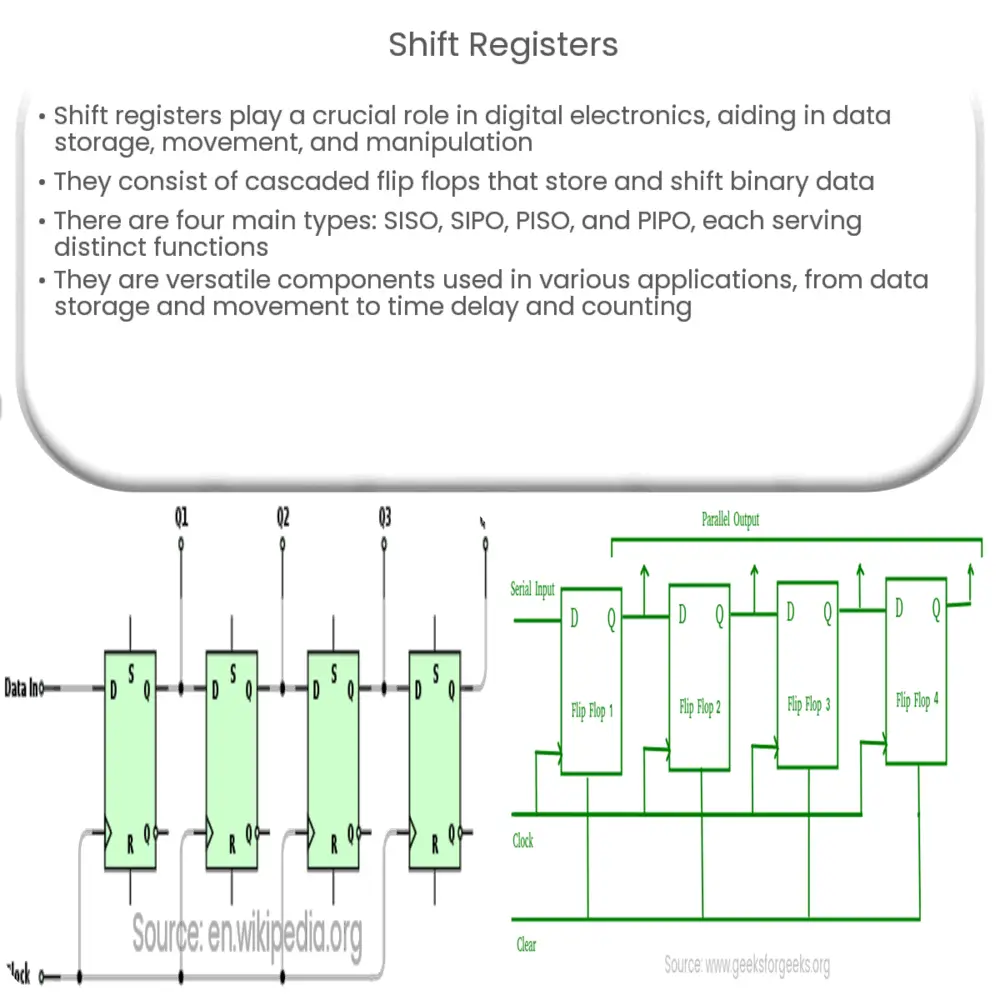Explore the fundamentals of shift registers in digital systems, their types, working principles, applications, advantages, and limitations.

Introduction to Shift Registers
Shift registers are an essential component in digital electronics and computer engineering, playing a crucial role in data storage, movement, and manipulation. They are used in a wide range of applications, from small embedded systems to large-scale computing architectures. Understanding the concept and operation of shift registers is vital for anyone seeking a deeper understanding of digital systems.
What are Shift Registers?
At its core, a shift register is a cascade of flip flops, sharing the same clock, in which the output of one flip flop is connected to the ‘data’ input of the next. They are sequential logic circuits capable of retaining and shifting binary data. Think of them as a chain of storage units, each capable of storing a single bit of data.
Types of Shift Registers
There are four main types of shift registers, each with distinct operational characteristics:
- Serial In Serial Out (SISO): In this type of shift register, data is input and output in a serial manner, one bit at a time. It is commonly used when there is a need to control data flow in a linear, step-by-step manner.
- Serial In Parallel Out (SIPO): This type is used when input data needs to be converted from serial form to parallel form. This means, while the data enters one bit at a time, it is output in a ‘parallel’ manner, all at once.
- Parallel In Serial Out (PISO): Conversely, a PISO shift register takes parallel data input and provides a serial output. It is often used in applications that require data to be compacted into a linear form before transmission.
- Parallel In Parallel Out (PIPO): Here, the data input and output are both in parallel form. This type is typically used when the need is to hold or store multiple bits of data simultaneously.
Working Principle of Shift Registers
The operation of shift registers is dictated by the clock signal, which controls the movement of data. When the clock signal changes from low to high (a condition known as a ‘clock pulse’), the data stored in the register is moved or ‘shifted’ from one stage to the next. The direction of shift can be either left or right, depending on the specific design of the register.
Applications of Shift Registers
Shift registers have a wide array of applications in digital systems. Let’s look at some of them:
- Data Storage: Shift registers can be used to temporarily store data. In a computer system, they can be used to hold data that is being transferred between different parts of the system.
- Data Movement: They can control the flow of data, acting as a pipeline that moves data from one place to another within a system.
- Data Manipulation: Shift registers are also used for various data manipulation tasks. For instance, they can perform operations like serial-to-parallel conversion, parallel-to-serial conversion, and bit rotation.
- Time Delay: They are used to introduce a deliberate delay in digital signals. Each stage of the shift register introduces a delay of one clock cycle, which can be useful in synchronization and timing operations.
- Counters: Shift registers can also function as counters. By applying certain input patterns and feedback mechanisms, they can be made to count in a particular sequence.
- Compactness: They can store multiple bits of data in a small space, making them efficient for use in compact digital devices.
- Flexibility: Shift registers can be used in a variety of configurations and applications, from data storage and manipulation to time delay and counting.
- Low Power Consumption: They generally consume less power than other types of storage devices, making them suitable for battery-operated devices.
- Speed: The operation of a shift register is limited by the speed of the clock. If the clock frequency is too high, the data may not be reliably stored and shifted.
- Finite Storage: Each shift register can only store a limited amount of data, defined by the number of stages or flip-flops it contains.
Advantages and Limitations of Shift Registers
Shift registers offer a number of benefits:
Despite these benefits, shift registers do have some limitations:
Conclusion
In conclusion, shift registers are fundamental components of digital systems, enabling efficient storage, movement, and manipulation of binary data. Their versatility and compactness make them suitable for a wide range of applications, from simple embedded systems to complex computer architectures. However, it’s also important to be mindful of their limitations, such as speed and finite storage capacity, when designing systems that use shift registers. Nevertheless, their benefits far outweigh their limitations, making them an essential part of modern digital systems.

